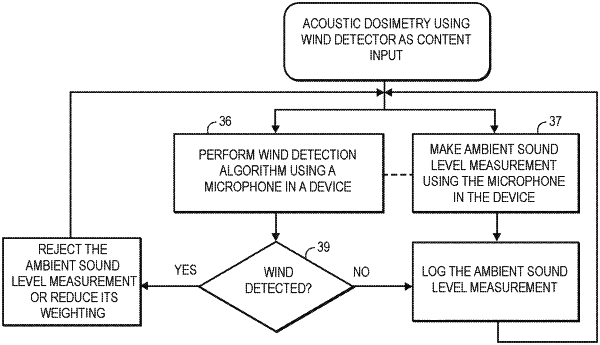| CPC H04R 29/008 (2013.01) [A61B 5/12 (2013.01); A61B 5/6817 (2013.01); G01H 3/14 (2013.01); G01H 11/06 (2013.01); G06F 3/165 (2013.01); G06F 16/61 (2019.01); G06V 10/44 (2022.01); H03G 11/008 (2013.01); H04R 2460/15 (2013.01)] | 19 Claims |

|
1. A digital signal processing method for acoustic dosimetry, the method comprising:
receiving an ambient sound measurement made using a microphone that is integrated in an audio device of a user;
receiving a first context input being an output of a wind detector;
determining whether to reject or reduce weighting of the ambient sound measurement based on the first context input and based on determining whether the user has passive hearing protection against their ear during the ambient sound measurement, and in response rejecting the ambient sound measurement or reducing the weighting of the ambient sound measurement,
wherein a level of reduction of the weighting is dependent on determining whether the user has passive hearing protection against their ear during the ambient sound measurement,
and wherein determining whether the user has passive hearing protection against their ear comprises a processor:
prompting the user to manually select from a list of hearing protection, and accessing a stored knowledge of how much to deduct from the ambient sound measurement based on knowledge of a specific type of passive hearing protection being one of a pair of headphones, a pair of dedicated ear plugs, a pair of sealing type earbuds, a pair of loose fitting earbuds, or a smartphone or against the ear usage of the smartphone; and
converting the ambient sound measurement and the weighting into in-ear sound pressure level, SPL, and appending the in-ear SPL to a stored time sequence; and
analyzing the stored time sequence to determine whether a total sound exposure for the user exceeds a threshold level over a threshold time interval.
|